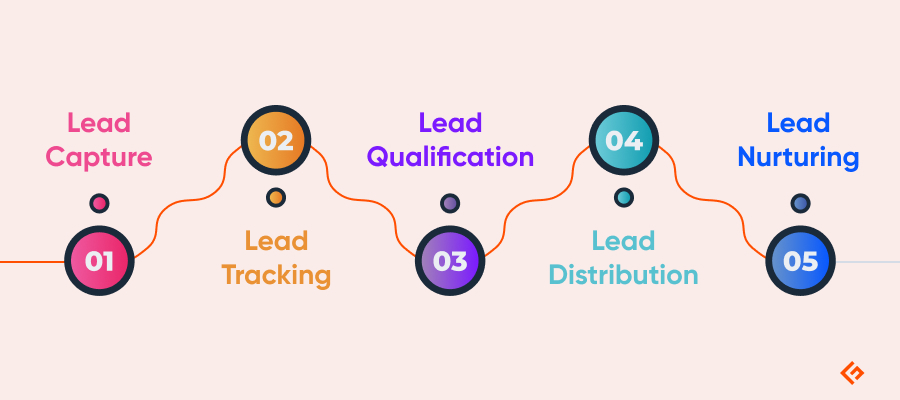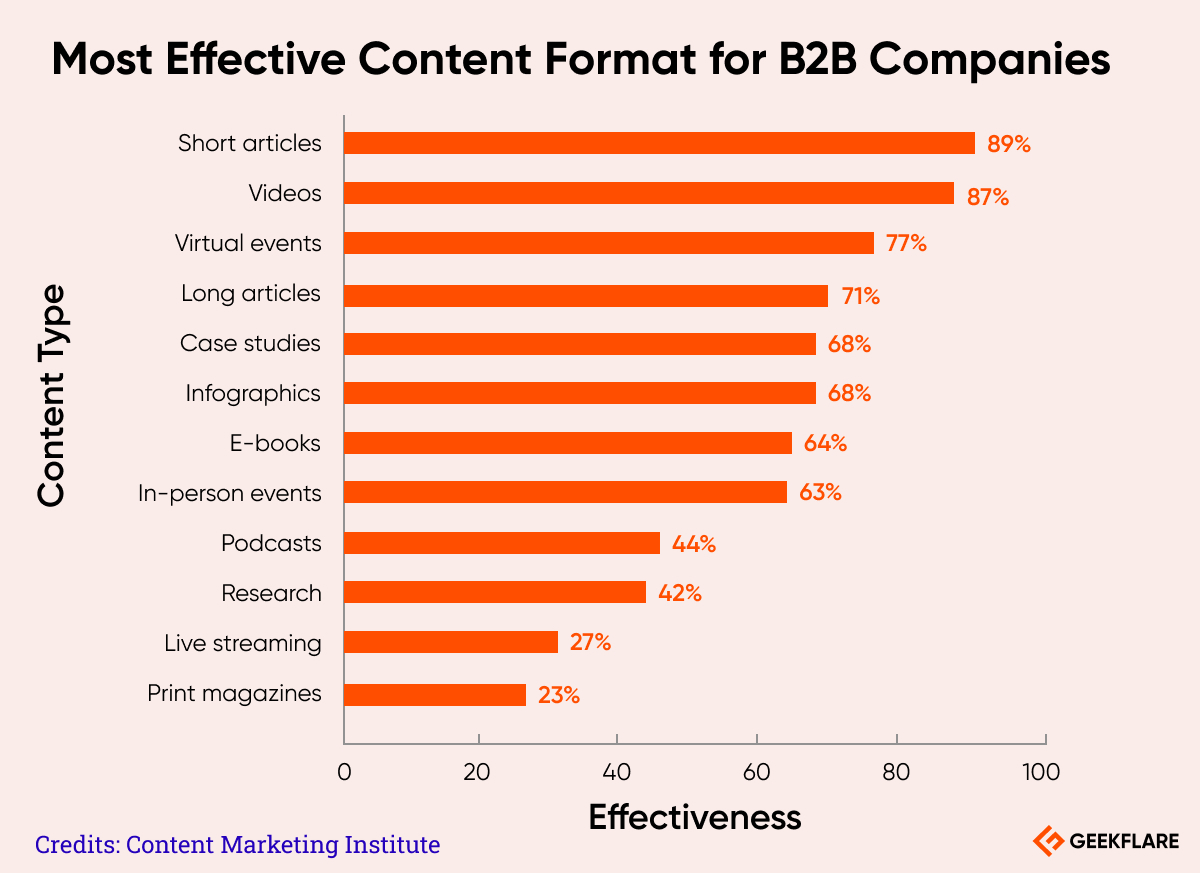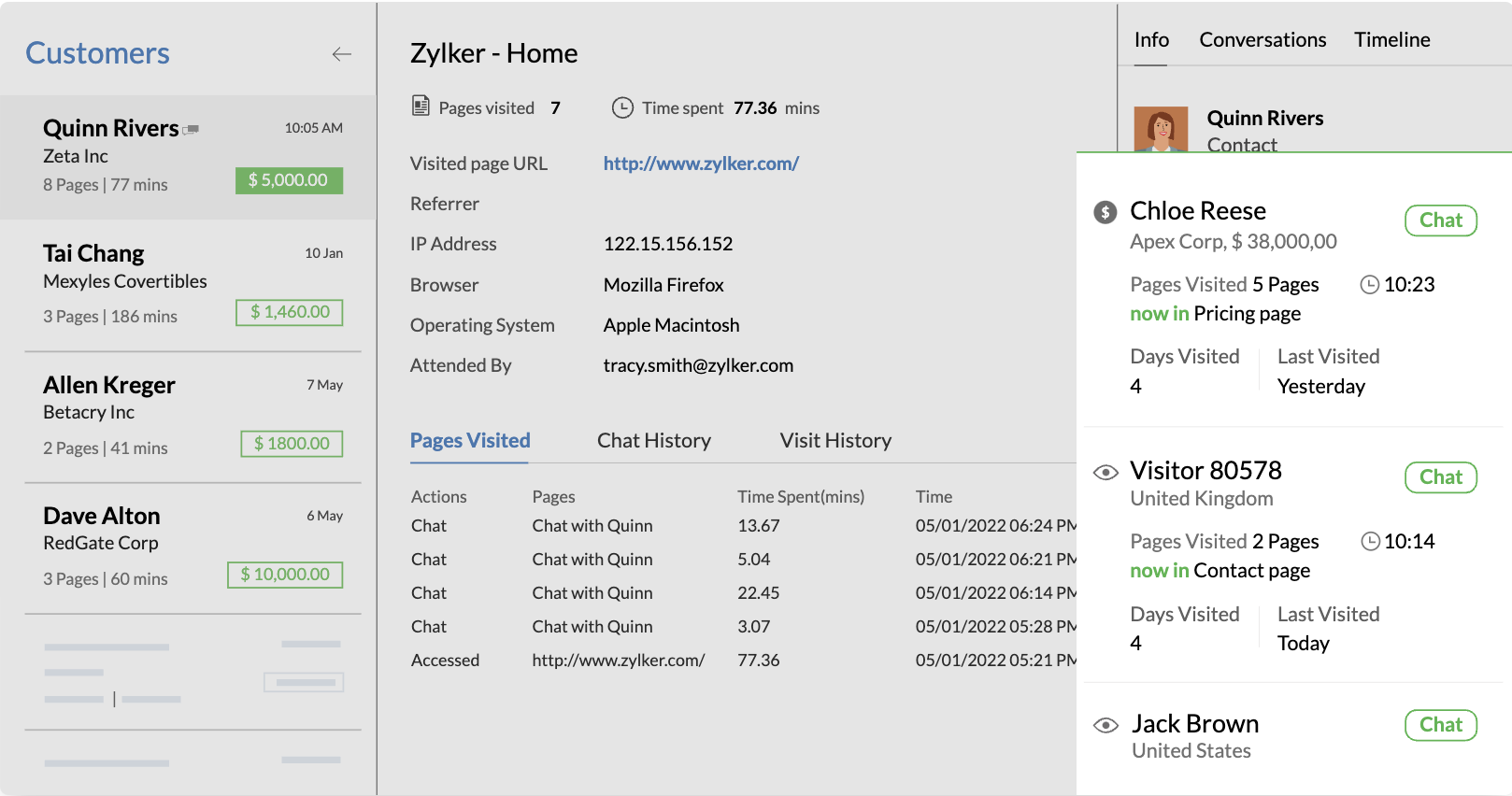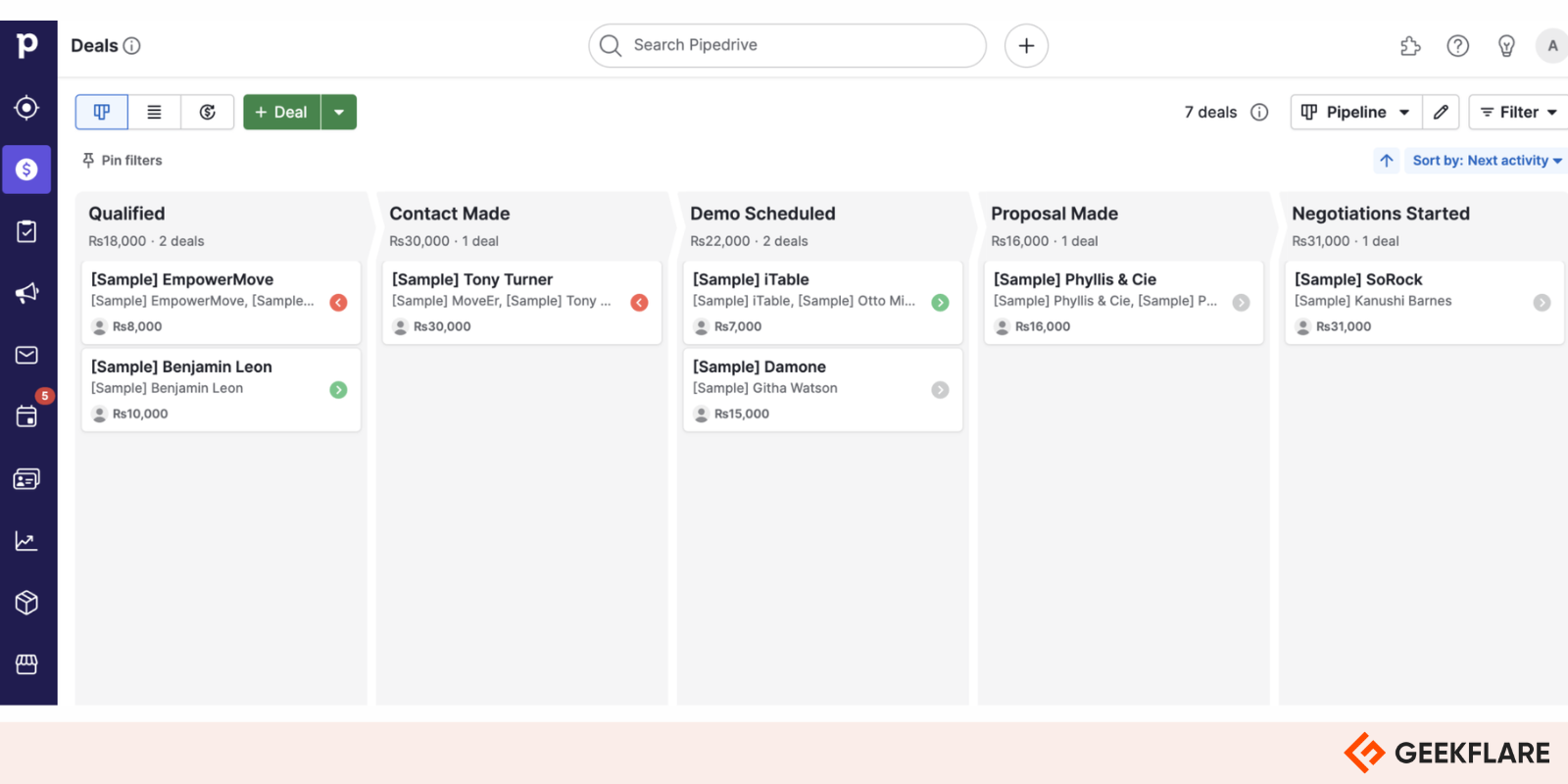From intent to purchase, a typical B2B sales cycle can go on for weeks or months. You never know.
During this time period, it’s important for you to consolidate, manage, and analyze leads so they are ready to be converted into customers.
Walking the sale process alone is overwhelming and time-consuming. So, a proper lead management system helps capture, prioritize, and assign the right leads to the right sales rep, thereby reducing lead leakage.
In this article, we’ll understand the lead management process: stages, benefits, challenges, strategies, and tools to successfully implement lead management into your business.
What is Lead Management?
Lead management is a systematic process of collecting, managing, and analyzing data of individuals or businesses interested in your product or services.
For example, If a user sees your Instagram ad and clicks the CTA, he’ll be considered a lead.
However, in a B2B setting, I define a solid B2B lead as filling out a form, subscribing to a newsletter, abandoning a shopping cart, or sending a direct inquiry.
So, the definition of a lead can vary from business to business. To find and supply quality B2B leads to your marketing and sales teams, the lead management process comes into play. It’s divided into five stages:
- Lead Capture: Gather lead data from various sources, like landing pages, forms, social interactions, ads, etc.
- Lead Tracking: Identify lead source and track lead journey across multiple touchpoints to identify interests and personalize communication
- Lead Qualification: Assess leads based on their interest level, budget, decision-making authority, and business fit
- Lead Distribution: Categorize and assign leads to respective sales reps. For example, whether it’s a small, medium, or enterprise-size business
- Lead Nurturing: Engage with sales-qualified leads and build relationships until they convert
At times, Lead Management and Customer Relationship Management (CRM) are used interchangeably because both require consistent engagement with leads. However, there’s a fine line between them.
Lead management is pre-sales. It focuses on the early stages of a potential customer’s journey and is about managing them until they make a purchase.
On the other hand, Customer Relationship Management (CRM) involves managing relationships with existing and new customers even after conversion. It’s an ongoing process to keep customers engaged and heard as long as they are in business with you.
Let’s understand the lead management process stage-by-stage.
What Is Lead Management Process?
The lead management process has five stages: Capture, Track, Qualify, Distribute, and Nurture.

1. Lead Capture
Lead capturing involves collecting data about potential customers interested in your product or service. Some of the signals include:
- A visit to your website
- Submitting the ‘Get a quote’ form
- Download a content, say a template or eBook
- Subscribe to your newsletter
- Attending a company event or webinar
Remember, in this stage, we are simply collecting all leads, good or bad. So, any actions or events that fit your business criteria for a lead can blend into this stage.
💡Tip
Effective lead capture strategies involve offering value in exchange for the lead’s information, creating a win-win situation.
I researched some B2B case studies, and here’s what I found:
- Ebooks remain the most popular form of lead magnet[1] for B2B companies
- 68% of B2B businesses[2] use landing pages to generate and capture data
- 58% of B2B companies[3] use live bots to capture high-quality leads from website
2. Lead Tracking
Lead tracking involves monitoring lead behavior, preferences, and actions throughout the buying process. By analyzing interactions—such as website visits, email engagement, and content downloads—you assess which leads are ready to buy.
For instance, knowing when a lead engages with certain content allows you to follow up with personalized messaging.
In this stage, you segment leads based on various criteria such as engagement level, demographic information, interests, or specific behaviors.
Manually, doing these might take a decade. And so, many tools help me track leads without lifting my fingers.
- HubSpot helps easily access each lead’s history, including company information and a timeline of every touchpoint between the contact and your business.
- Pipedrive allows you to track and score leads. Coupled with its Salespanel integration, I could track and score leads as they engaged with emails or website content. Their activities were automatically logged and synced with Pipedrive, making it easy for me to manage leads under one roof.
Once you know a prospect’s journey, it’s time to qualify and score them.
3. Lead Qualification
In this stage, you determine whether a lead is a good fit for your business. In general, the qualification is between Marketing Qualified Leads (MQLs) and Sales Qualified Leads (SQLs).
💡 Know The Term
MQLs require some pampering from your marketing team before they are ready to purchase. SQLs have already interacted with your brand on multiple occasions and are ready to make a purchase.
To assess lead quality, I use the BANT framework, which includes:
- Budget: Does the lead have the financial capacity to purchase your product?
- Authority: Is the individual you’re communicating with a decision-maker?
- Need: Does the lead have a genuine requirement for your product or service?
- Timing: What is the lead’s timeline for making a purchasing decision?
Additionally, I use ‘Lead Scoring‘, where I assign point values or weightage to leads based on their attributes and behaviors aligned with the BANT criteria.
For example, leads can be scored on a scale from 1 to 10 based on their budget, authority, need, and timing. Higher scores indicate better fit and quality.
4. Lead Distribution
Once you’ve got a list of qualified leads, you distribute them to appropriate sales reps. This distribution can be based on any custom criteria you set, such as deal size, location, product interest, lead score, etc.
For example, one team can specialize in small to mid-sized companies, while another works with large enterprises. Similarly, you can distribute leads based on regional preference and team availability.
Generally, in B2B companies, leads are distributed via various models:
- Round-robin: This model distributes leads evenly among sales reps, ensuring that all team members have equal opportunities to engage with new prospects
- Territory-based: Leads are routed to reps based on geographical territories, ensuring that salespeople familiar with specific regions and languages handle relevant prospects
- Lead score: This model prioritizes leads based on their BANT or lead score, directing higher-scoring leads to more experienced reps
- Availability-based: Leads are assigned to the first available rep, which helps in improved First Response Time (FRT) but may not always consider the expertise of the rep
However, manually distributing leads might create chaos, so I suggest using AI-powered CRM or marketing automation tools like Zapier to streamline lead routing.
These tools automatically assess and assign leads based on real-time data and predefined rules, significantly reducing manual errors and improving response times.
5. Lead Nurturing
Lead nurturing is a well-thought-out process of establishing and building meaningful relationships with prospects.
In this stage, the primary objective is to increase customer engagement and knowledge about your products and services, whether it involves sharing relevant content, guiding them through a product tour, answering queries, etc.
❓Did you know
80%[4] of new leads never convert into sales due to a lack of lead nurturing.
Put simply, lead nurturing is when your Sales team’s skills are tested. Not to worry, I know of some proven lead nurturing strategies:
Email Marketing
77% of B2B buyers[5] prefer to be contacted over email. It’s a direct and professional way to build strong 1:1 connections with your audience.
The DemandGen Report states that lead nurturing email marketing campaigns have up to 10 times the response rate[6] of standalone email blasts.
Content Marketing
An average B2B buyer consumes at least 13 content pieces[7] before purchasing. 90% avoid cold calls.
🎯 Fact
Content marketing brings 3X more leads[8] than traditional marketing
According to CMI[9], articles, videos, and virtual events are the most popular ways to interact with audiences.

The reason is simple: These content types offer value and foster connection. They tell a story, evoke emotion, and present a face to which the audience can relate.
Social Media Engagement
75% of B2B buyers[10] use social media to assist in their purchasing decisions. Being there when they are searching for your product or competitors can be all the luck you need.
But with so many social networks, which one should you focus on most?
Well, over 80% of B2B leads[11] on social media originate from LinkedIn. Second, to email, LinkedIn is the most professional way to connect with your leads—whether they are employees, decision-makers, or industry leaders.
What are the Benefits of Lead Management?
Below, I have shared a few benefits of lead management.
- Improved sales and marketing alignment: Lead management brings together teams as it forces them to collaborate on defining qualified leads and distributing them accurately. This alignment leads to improved lead quality, as both teams can define what constitutes a qualified lead more effectively.
- Higher lead-to-customer conversion rates: According to HubSpot, companies with a strong lead management process generate 50% more sales-ready leads at a 33% lower cost.
- Enhanced customer experience: Efficient lead tracking and management helps you personalize your outreach to prospects. You learn about their behaviors, preferences, choices, and the right time and place to follow up.
- Better decision-making with data-driven insights: Most lead management tools centralize all lead-related information and analyze them to provide insights into lead behavior and campaign effectiveness, allowing businesses to refine their strategies based on real-time data.
What are Some of the Popular Lead Management Software?
Here are the popular lead management software.
1. HubSpot
HubSpot is a free lead management and tracking software that enables you to organize, prioritize, and engage leads under one roof. It is trusted by 200k+ customers in over 135 countries, including Reddit, DoorDash, WWF, and more.

HubSpot’s lead management features include:
- Store and access all lead-related information and past journeys from a centralized dashboard
- Automatically prioritize leads with custom scoring criteria and grow your database with smart segmenting and nurturing features
- Use contacts’ histories to create segments based on website visits, email interactions, and more
- Built-in reporting tools that allow users to track lead generation performance and analyze conversion rates
- Set up workflows to route leads to the right reps and trigger personalized marketing content and email campaigns
What do I like about HubSpot?
It’s free for up to two users, making it an excellent choice for freelancers and solopreneurs. As you upgrade and add more users, it does get pricier, but the added benefits, like process automation and AI-powered content creation tools, make it a valuable investment.
2. Zoho Lead Management
Zoho is AI-powered lead management software. I recommend it for businesses that are already part of Zoho’s ecosystem via apps like Zoho People, Zoho Inventory, and more.

With Zoho CRM’s lead management, you can:
- Automatically capture leads from various sources such as web forms, social media, and emails to ensure no potential customer is missed
- Use Zia, Zoho’s proprietary AI, to enrich leads with more information and automatically score and sort them using custom scoring rules
- Organize leads based on industry, location, or behavior and assign scores based on engagement levels to prioritize follow-ups
- Automate repetitive tasks such as sending follow-up emails or assigning leads to sales representatives, increasing efficiency
- Integrate with other tools and platforms (e.g., email marketing and social media) to enhance lead management capabilities
- Access detailed reports and analytics on lead performance, conversion rates, and sales funnel forecasts to make informed decisions
What do I like about Zoho CRM?
It is accessible on mobile. Zoho offers a dedicated mobile app that allows you and your team to manage leads while on the fly.
3. Pipedrive
Pipedrive’s sales lead management software helps 100k+ companies improve sales momentum and boost conversion rates. It improves the number of quality deals in your pipeline by 93% and reduces the time taken to close a deal by 46%.

Key features include:
- Built-in lead information system that extracts lead information from the web, such as contact details, email address, industry, job profile, and more.
- Use Chatbot and Livechat to engage, nurture, and qualify web visitors for smoother lead management.
- Track visitor activity on your website and identify companies most likely to make a purchase.
- Use Prospector to find high-quality leads based on custom criteria and optimize your pipeline for better conversion rates.
What do I like about Pipedrive?
Pipedrive has a built-in lead database, so it’s likely easy to find information about prospects. It also offers web forms and chatbots for efficient lead capturing. However, what appeals to me most is Pipedrive’s customizable interface. I couldn’t feel the vibe with HubSpot and Zoho.
5 Challenges in Lead Management
The 5 major challenges in lead management are as follows:
1. Poor Lead Quality
Poor lead quality is the top complaint among sales teams handling inbound leads.
While generating a high volume of leads is necessary to meet targets, focusing solely on quantity results in an influx of low-quality leads that are unlikely to convert.
2. Ineffective Lead Scoring
Many businesses fail to implement clear and systematic lead-scoring systems. This results in slower growth, missed opportunities, and wasted resources on unqualified prospects.
Without a standardized process, sales teams may engage with leads that do not align with their target market, reducing overall efficiency
3. Inefficient Lead Nurturing
Lead nurturing is driven by patience. It can last from a few days to months. However, most businesses rush through it to meet sales targets and fall into the trap.
4. Data Overload
This is again the quantity vs quality debate. The vast amount of data generated from various marketing channels poses a challenge in lead management. Organizations often struggle to manage this data effectively, leading to inaccuracies and difficulties deriving actionable insights.
5. Difficulty Measuring ROI
Measuring the ROI from lead management efforts is not easy. Therefore, most B2B marketers shy away from analyzing which channels bring them solid leads and are cost-effective to the businesses.
How to Overcome These Challenges
The above-mentioned challenges can be resolved if these lead management strategies are put into play:
1. Implementing AI-driven Tools for Lead Scoring and Analytics
Lead scoring and analytics are based on a number of factors.
What kinds of behaviors do your leads exhibit? Are they reading your content? Are they responding to email or Short Message Service (SMS) messages? Are they coming back to your website? If they’re on your website, what are they looking at?
It would take ages to compile this information manually. Fortunately, a lead management solution can automatically gather the data on all of your leads.
For example, HubSpot and Zoho are best for tracking and scoring leads based on your custom criteria. Over time, these systems build detailed lead profiles with the lead’s interests, location, career, time zone, and more.
HubSpot even offers AI-powered lead scoring and reporting tools.
2. Fostering Better Collaboration Between Sales and Marketing Teams
Poor lead quality, untimely messaging, ineffective follow-ups, premature lead engagement, and siloed operations are among the grave impacts of poor collaboration.
If you’re a manager or business owner, you play a pivotal role in improving collaboration between sales and marketing teams. Here’s what you can do:
- Schedule consistent meetings between sales and marketing teams to foster open dialogue, share insights, and address challenges collaboratively.
- Align shared goals for sales and marketing teams related to lead quantity, quality, and conversion rates.
- Use lead management tools that offer built-in chat and commenting for instant communication.
- Implement SLAs that outline the expectations for lead handoff between marketing and sales, ensuring a seamless transition and accountability for both teams.
3. Regularly Auditing and Cleaning Lead Databases.
Suppose I’ve generated 1000+ leads through paid campaigns and other marketing channels. What should be the percentage of qualified leads?
Well! The acceptance rate of marketing qualified leads (MQLs) by sales teams is reported to be around 34%[12]. This suggests that a substantial number of leads are filtered out before they can be considered viable opportunities.
I find Pipedrive’s Lead Inbox function very effective for this process. It allows me to store incoming leads in the Leads Inbox until I’m ready to qualify them. Then, help me declutter my lead database with features like Filter, sort, and edit, and then add activities to stop them from getting cold.
4. Investing in Robust and Integrated Lead Management Software
Lead management, if done the old-school way, would end up taking months. Instead, you could invest in powerful lead management software and use the spare time to build strategies.
5 Best Practices for Effective Lead Management
The 5 best practices for effective lead management are as follows:
- Define clear goals and objectives: Create specific, measurable, achievable, relevant, and time-bound (SMART) goals for your lead management efforts, align objectives with the sales and marketing team, and keep everyone on the same page
- Develop a strong lead qualification process: 66%[13] of business leaders cite establishing a lead-qualifying and scoring method as one of the most effective ways to eliminate unqualified leads and fill in the sales funnel with high-value leads
- Personalize communication and nurture leads: Use lead data and analytics to personalize reachouts. 84%[14] of decision-makers in B2B companies said that being treated like a person was a top factor in winning their business
- Use data and analytics to track progress and optimize strategies: Invest in Lead management tools such as HubSpot, Zoho, and Pipedrive that offer built-in reporting and analytic tools to optimize marketing strategies with data-driven decisions
- Continuously evaluate and improve the lead management process: The B2B industry is dynamic, so it’s important to build marketing strategies that are flexible and iterateable with changing environments and customer preferences
References
View Details
6. DemandGen Report on Response Rate
9. CMI Report
10. American University Study on B2B Buyers
11. LinkedIn Stats for B2B Marketing
12. Gartner Insights on Sales Qualified Leads
What’s next?
Now that you have understood the lead management concept, let’s explore the guides on sales management.
-
 EditorRashmi Sharma is an editor at Geekflare. She is passionate about researching business resources and has an interest in data analysis.
EditorRashmi Sharma is an editor at Geekflare. She is passionate about researching business resources and has an interest in data analysis.





